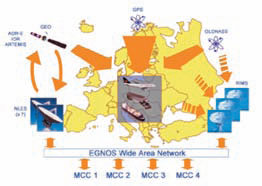
Galileo and GPS systems to work together
The UK government has published the agreement between it and fellow European governments, and the USA, over the promotion, provision and use of the Galileo and GPS systems.
After many years of wrangling, the Galileo project was finally given the go-ahead by the European Union back in December 2007. Galileo is intended to be an independent alternative to America’s GPS. As recently as the year 2000, the US only provided limited access to GPS to the general public.
Both the United States and the EU signed an agreement way back in June 2004 that GPS and Galileo signals would be interoperable, but it has taken several years for the agreement to be approved by member states. www.techworld.com

ESP SAS formed
ESSP SAS has been recently formed in Rome with objective to become the certified service provider for EGNOS. The Headquarters will be in Toulouse having two units: the Service Provision unit in Madrid and Operations in Toulouse. The negotiations between the European Commission and the EOIG experts have reached a conclusion on the EGNOS Agreement and foresee to initial the Agreement in the coming weeks.michel. calvet@aviation-civile.gouv.fr

China to investigate Google for illegal maps
China has launched an investigation into online mapping services by Google and Sohu in an effort to protect state secrets and territorial integrity. According to vice head, State Bureau of Surveying and Mapping, authorities hope to get rid of online maps that wrongly depict China’s borders or that reveal military secrets. The government began the investigation into the problematic maps in April and will continue it until the end of the year. Min cited five areas of concern – Taiwan, the Spratlys and Paracels island chains in the South China Sea and the Diaoyu Islands in the East China Sea. http://afp.google.com/

Very Long Baseline Interferometry (VLBI) is the unique space
geodetic technique which can provide the Celestial Reference Frame (CRF), the Terrestrial Reference Frame (TRF) and the relationship between the two frames — Earth Orientation Parameters (EOP) at the same time. VLBI has a widely usage in space geodetic, ground
geodetic, geophysical fields and so on. Presently, it can determine the position of the radio source outside the galaxy with 1mas precision, and determine several kilometers length of baseline on the earth’s surface with 1cm precision. Due to its high stability and high precision character, the Celestial Reference Frame outside the galaxy based on VLBI has been the best realization of the quasi-inertial referenceframe since 1980s. VLBI stations are the most important benchmarks in the International Terrestrial Reference Frame (ITRF), and VLBI is one main supporting technique which determines EOP. Till now, space and ground VLBI have accumulated more than 20 years’ data. They provide continuous and long-term data guarantee for space geodetic, ground
geodetic and geographical research.

Canalys surveys Taiwanese and Indian consumers about navigation and LBS
Market research firm Canalys highlighted a recent consumer survey in Taiwan for GPS navigation and LBS on mobile phones and PNDs. The survey found more than 80% of Taiwanese being familiar with what satellite navigation could do. With 60%, the idea of searching for directions on the web and printing them out was either the first or second most common method used to plan a route when travelling to a new place for the first time. http://gpsbusinessnews.com

RMSI ranked the ‘Best Workplace’ across all industries in India
RMSI has been ranked first in the Top 25 Great Places to Work in India by a study conducted by the Great Place to Work® Institute, US, along with The Economic Times, a financial daily in India. RMSI provides geospatial services, consulting to application development to spatial analysis and modeling to remote sensing and data conversion. www.rmsi.com

Satellite remote sensing has been used to varying degrees around the
world for over three decades. Over that time the degree to which the technology has been applied has varied greatly from country to country – from being broadly embraced to being used hardly at all. Simply stated, where remotely sensed data and related geospatial data are used in a limited fashion the full economic and social value of the data for resource evaluation, sustainable resource management, and environmental protection is not realized. This paper examines the key factors that appear to be associated with varying use of the data and consequent derivation of benefits. At one time it was thought that this use was related to the economic situation within a country or the quality of training and education. While these factors are of course important, this work isolates other factors as being equally if not more important. These factors include data policy, approaches to commercialization, the level of applied research and links to “real” users. This paper explores the importance of these other factors with special reference to data policy in Thailand and Canada.

The current GPS civil service provides suitable performance only in situations of good electromagnetic visibility; the positioning becomes difficult in severely signal degraded environments, e.g. mountainous or urban areas, where a lot of GPS signals are blocked by buildings or
natural obstacles. The GPS gaps can be partially solved employing spacebased augmentations systems; in this paper we consider geostationary and geosynchronous constellations. A simulation software has been developed in MATLAB® environment in order to study the integration of existent and feasible constellations.











 (5.00 out of 5)
(5.00 out of 5)